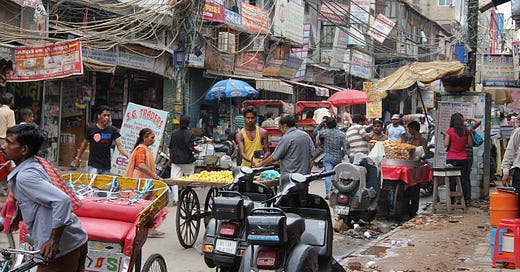‘Just shifting the goalposts’: Big question marks remain over India’s new anti-pollution law
Yet another commission could just add to India's clunky bureaucracy
Welcome to Lights On, a newsletter that brings you the key stories and exclusive intel on energy and climate change in South Asia.
A big thank you to my new subscribers - I am trying to add 100 sign-ups before the paywall goes up on Monday and I am almost halfway there!
The Monday news briefing will remain free, but if you choose to become a member you will get full access to in-depth stories like my deep dive on Delhi’s unregulated waste problem, which is compounding the pollution crisis, and the exclusive interview with Andrew Light, former Obama climate negotiator, who speaks about the importance of the US elections for India’s energy transition path.
If you decide to become a member, your money doesn’t just pay for my work, but helps keep this project alive in the long term for many others too. So if you can afford it, consider becoming a founding member, and I promise it will be worth it.
Otherwise, grab your 20 percent discount by this Sunday!

Market road in Delhi - Image credit: Rhiannon/Pixabay
Launched by the government this week, a new body for air quality management promises to tackle air pollution on a ‘war footing’ in Delhi and the surrounding states of Uttar Pradesh, Haryana, Punjab and Rajasthan.
The new Commission for Air Quality Management wants to do away with the flurry of half baked pollution control efforts that so far have achieved next to nothing, replacing them with a more powerful entity enshrined in Indian law. But to many, it’s ‘just another commission’, a new chapter in a decades-long streak of failures.
The commission’s focus areas will be threefold: air pollution monitoring, enforcement of laws informed by the monitoring activities, and research and innovation. It plans to regulate or ban activities that are likely to increase air pollution, and will set emission standards across various sectors and sources. It will also be tasked with inspecting any industrial infrastructure to make sure it complies with the safe emissions limits - and order its closure if it doesn’t. Penalties for non compliance have been enhanced to up to $134,000 (10 million rupees) or five years in jail.
Just another commission
The new law is an attempt to turn around the air quality story in the world’s most polluted capital, but Indians remain sceptical. “My problem with such a hurried and not-so-thought-through legislation, [is that] we end up creating a multiplicity of institutions, instead of strengthening the existing ones,” says Sanjay Upadhyay, a Supreme Court advocate and the founder of India’s first environmental law agency, Enviro Legal Defence Firm.
“One of the key instruments that was available to us was the Air Pollution Act, which was enacted in 1981,” he says. “We should have strengthened that”.
Too many laws in India are robust on paper only, and many are disappointed to see yet another bureaucratic body that promises great things but doesn’t lay out a pragmatic path to achieve them.
“The major issue with the ordinance will be when it comes to implementation, as EPCA [the Environment Pollution (Prevention & Control) Authority which the new commission is replacing] had almost similar powers but failed miserably in cleaning the air even after being in force for more than 20 years,” says Sunil Dahiya, an analyst at the Centre for Research on Energy and Clean Air (CREA). Another major issue, he adds, “is that the ordinance again emphasises that the lives of people in other parts of the country are not valued as much as those of citizens in Delhi-NCR. We have hazardous air pollution throughout most of the country and the ordinance fails to address that.”
Some ideas may be good, but there’s no money to see them through. This was the case with the ambitious National Clean Air Programme (NCAP), launched just last year to target the country’s most polluted cities - Delhi being just one of them. Just a few months later, studies calculated that the program was so underfunded it was essentially doomed from the start - because India can’t deploy the monitoring stations essential to design the right interventions. In India, “we don't have a sound implementation arrangement,” Upadhyay says. “We rely on the same pollution control boards, which are understaffed and under-resourced, to do everything on the ground.”
A better way
A more useful if less flashy measure, he says, would have been to create a sound monitoring and verification machinery, “rather than a bureaucratic commission that is basically just shifting the goalposts.”
Air pollution in India has been widely studied, and by now policymakers have a pretty good idea of what the main sources are. The real challenge is how to solve the problem, Upadhyay says. For about two months a year, he says, Delhiites get worked up about problems like stubble burning in neighbouring states, which contributes to the thick smog that envelopes the capital in winter. But pollution is a systemic issue that can only be solved through a mix of targeted policies, all year round.
“Nobody's talking about a scrapping policy for existing old vehicles, and they account for 28 percent of the pollution [in the city],” he explains. Nobody's looking at the environmental impact of micro and small enterprises: there are about 42.5 million such businesses in India, which remain completely unregulated. Dust pollution, waste burning, or strategies such as syncronising traffic lights to avoid jams are never really discussed, says Upadhyay, but could make a real lasting impact. “You have to attack the desegregated problems, and only then you will have a solution”.
That’s all for today! A reminder that all my premium content is free until next week only. If you haven’t subscribed yet, you can do it below. As usual, you can get in touch with comments and tips by replying to this email.




good